15 Must-Know LinkedIn Marketing Tools for Businesses in 2025


15 Best LinkedIn Marketing Tools for Businesses in 2025
Table of Contents
Serious about growing your business? Let’s plan exactly how to get you more leads, sales, and results—faster.
LinkedIn is bigger and more active than ever in 2025.
- 1.2 billion+ members worldwide as of July 2025
- 1.77 billion monthly visits in February 2025
For businesses, LinkedIn’s impact is even more compelling:
- 89% of B2B marketers use LinkedIn for lead generation, with 62% reporting successful results—double the efficacy of other platforms.
- 97% of B2B marketers use LinkedIn for content marketing, and 58% say it delivers the best return on ad spend compared to other platforms
- LinkedIn generates leads 277% more effectively than other social platforms, outperforming competitors like Facebook and X by a wide margin.
These numbers prove one thing: LinkedIn remains the most powerful B2B marketing platform, perfect for finding clients, nurturing relationships, and generating high-quality leads.
In this guide, we’ve curated the 15 must-know LinkedIn marketing tools for businesses looking to thrive on the platform.
Whether you’re aiming to grow your audience, generate leads, or boost ROI, these tools will help your strategy stay ahead of the curve.
Marketing Research & Strategy
We help you understand your market and build smart strategies to attract more customers and grow faster.
- Detailed research into your competitors, customers, and market
- Custom marketing and growth plans that drive real results
- Clear action steps to increase traffic, leads, and sales
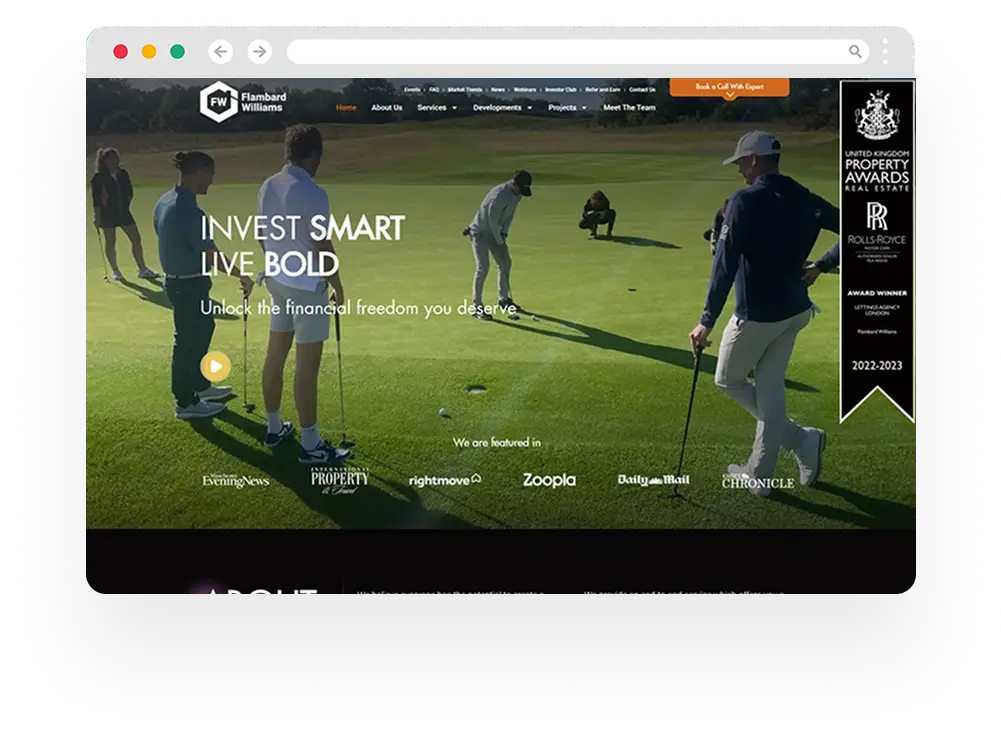
ADWORDS ROI
Cut Ad spend

Why Use LinkedIn Marketing Tools in 2025
LinkedIn marketing tools in 2025 give your business a clear edge by boosting reach, improving content performance, and turning engagement into leads faster.
They combine automation, personalisation, analytics, and professional design to make your LinkedIn strategy more consistent, efficient, and results-driven.
Top benefits of LinkedIn marketing tools:
1. Boost visibility & thought-leadership
AI content tools help you create high-impact posts, articles, and videos that position you as an expert in your industry.
They also allow you to optimise for trending topics, relevant keywords, and audience pain points, so your brand consistently appears in the right searches and discussions.
2. Amplify engagement
Tools like influencer tracking and optimal scheduling increase reach at the right times, fostering genuine interaction.
Businesses that expose audiences to both brand and acquisition messaging on LinkedIn see audiences become six times more likely to convert, demonstrating how strategic message layering drives engagement and conversion.
3. Optimise with analytics
Track impressions, clicks, demographics, and engagement rates to refine your content strategy for maximum ROI. With advanced insights, you can uncover which content formats resonate best and tailor campaigns to specific decision-makers within your target industries.
4. Automate & scale outreach
Tools like Zapier, Expandi, and Dripify save hours by automating lead generation, connection requests, and follow-ups. They maintain a steady flow of personalised messages, ensuring consistent prospect nurturing without overwhelming your schedule.
In fact, data from over 70,000 actual LinkedIn campaigns reveal that direct message (DM) response rates average around 10.3%, which is double the typical cold email rate of just 5.1%
This means every automated outreach effort can yield significantly better results—faster and more efficiently—boosting both connections and conversions in your pipeline.
5. Maintain visual consistency
Design platforms like Canva and template libraries help you keep a professional, recognisable brand across all LinkedIn content.
By standardising fonts, colours, and layouts, your posts build trust faster and reinforce your brand’s authority every time they appear in the feed.
Criteria for Selecting the Best LinkedIn Marketing Tools
We selected tools that do more than just “work” on LinkedIn—they give you a competitive advantage. Each integrates seamlessly with LinkedIn (natively or via trusted third parties) and delivers measurable value through automation, personalisation, or advanced analytics.
Every tool supports at least one key pillar of LinkedIn marketing: content creation and publishing, outreach and engagement, or visual branding.
They are cost-effective, with scalable pricing to suit individuals, SMEs, and enterprise teams.
All recommendations demonstrate proven ROI while keeping your account safe and compliant. Where possible, we’ve highlighted AI-ready and SEO-friendly features to ensure your strategy keeps pace with LinkedIn’s evolving algorithms, formats, and audience expectations.
Now that we’ve set the criteria, let’s see the 15 must-know LinkedIn marketing tools that can take your business to the next level.
The 15 Best LinkedIn Marketing Tools for 2025
A. Profile & Content Optimisation
1. Taplio
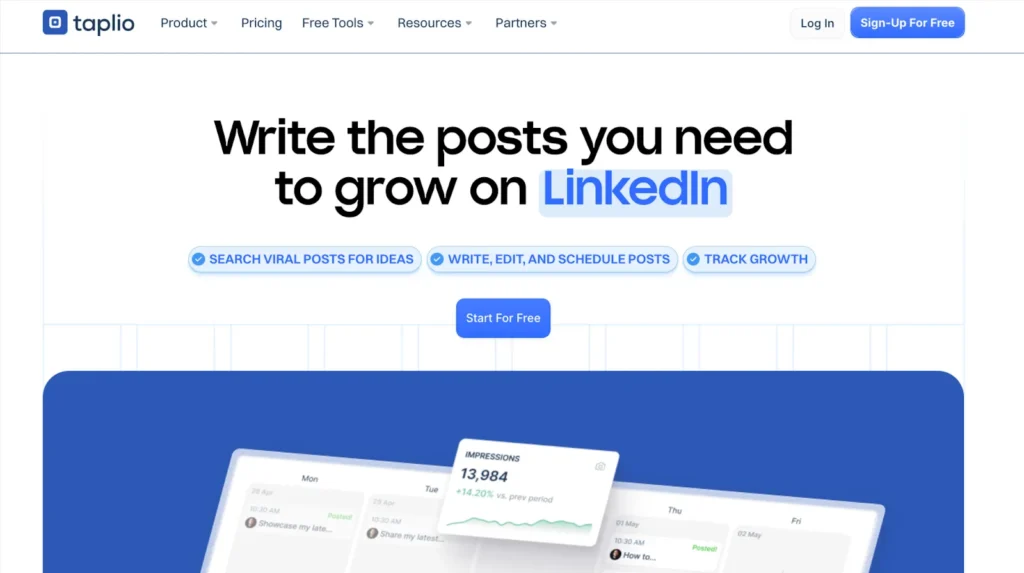
Source: Taplio
Taplio goes beyond content ideation; it’s a smart tool designed to help businesses refine their LinkedIn presence with data-driven insights.
Its Profile Optimisation feature examines your headline, summary, experience, and engagement patterns to suggest real-world tactics to stand out.
From recommending ideal post formats and headline variations to showing top-performing topics in your industry, Taplio serves as both a profile coach and a strategic content assistant.
You get visibility into what’s trending, what’s resonating, and how to deliver it effectively. Taplio offers a free version with basic content tools; paid plans start from $39 per month for the “Starter” tier, with more advanced features in higher tiers.
2. Canva
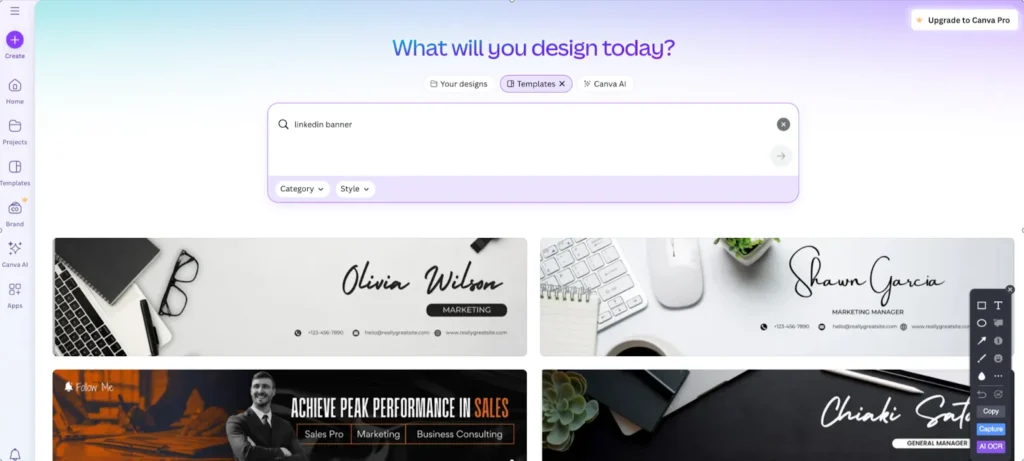
Source: Canva
Brand consistency is essential on LinkedIn, especially when targeting decision-makers. Canva lets your marketing team create professional banners, infographics, and carousel posts that align with your brand identity.
With its AI-powered design suggestions, teams can produce high-quality visuals in minutes and post directly to LinkedIn. Perfect for businesses that want to look polished without outsourcing design work.
Pricing: Free plan available; Pro costs £10.99/month or £99.99/year for advanced features like brand kits and premium asset libraries.
3. AnswerThePublic
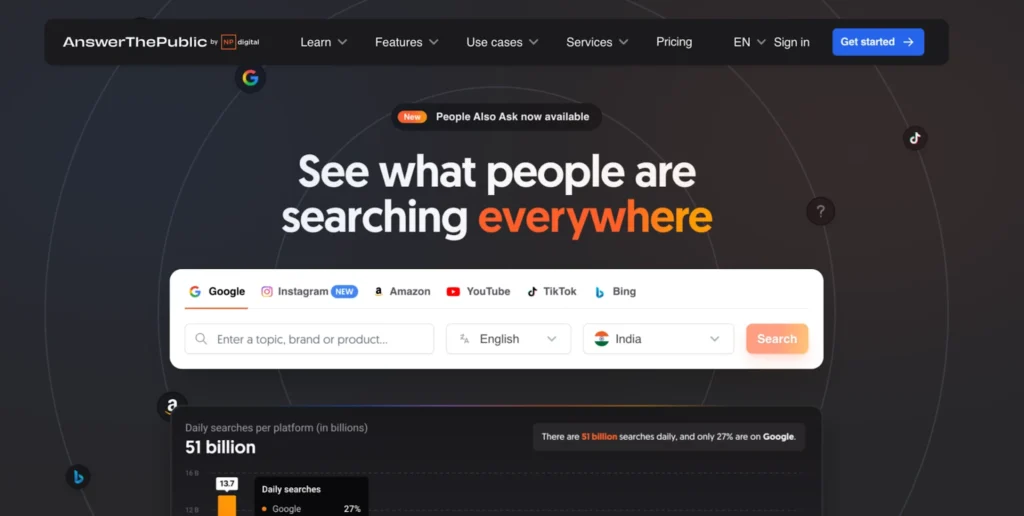
Source: Answer The Public
For B2B marketers, knowing exactly what your audience is searching for is key to posting content that cuts through the noise. AnswerThePublic turns real search query data into visual maps of trending questions and topics in your industry.
This insight helps your business craft LinkedIn posts, articles, and campaigns that meet current demand, position your brand as a thought leader, and spark meaningful conversations.
Pricing: Free plan with limited searches; paid plans start from $11/month (~£9) for individual use, with Pro at $99/month (~£78) for larger teams.
4. ChatGPT (with LinkedIn Post Wizard)
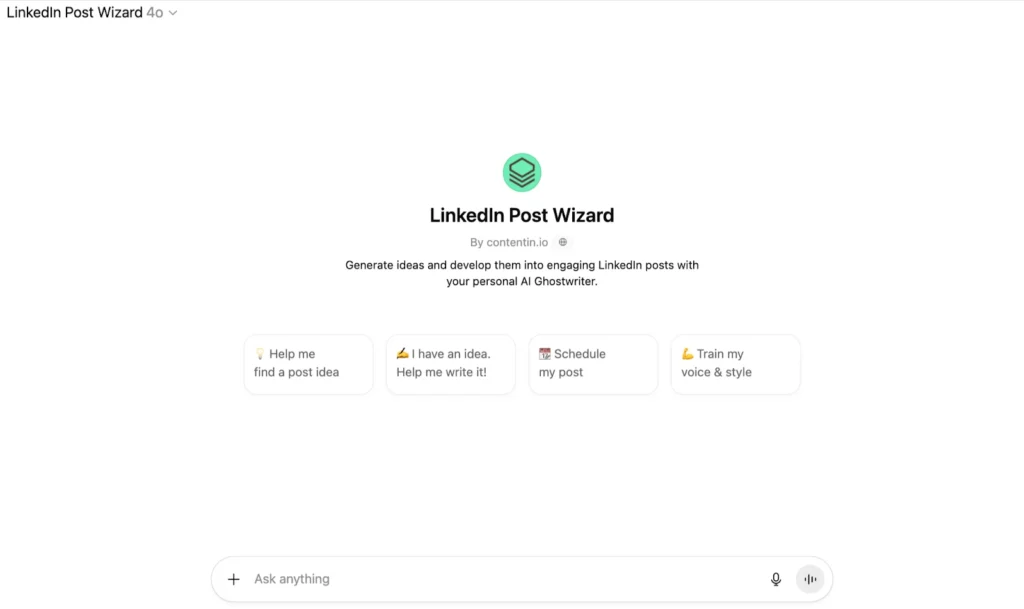
Source: ChatGPT
ChatGPT is a powerful AI assistant that helps businesses streamline content creation, research, and personalisation for LinkedIn campaigns.
It can generate post ideas, draft thought-leadership articles, refine outreach messages, and repurpose long-form content into bite-sized LinkedIn updates, all in your brand voice.
A standout LinkedIn-focused feature is the LinkedIn Post Wizard (powered by contentin.io). It develops post ideas into polished, engaging updates, learns your style, and allows direct scheduling.
You can start from scratch, refine your own ideas, or let it suggest topics based on trending conversations in your sector, keeping your LinkedIn feed active with high-quality, relevant content.
Pricing: Included with ChatGPT Plus and Enterprise plans (LinkedIn Post Wizard availability varies by region).
Digital Marketing, SEO & PPC
- SEO to boost rankings and capture high-intent, AI-driven traffic
- Performance Marketing to run ROI-focused campaigns that convert
- Content Marketing to drive clicks, earn links, and build authority
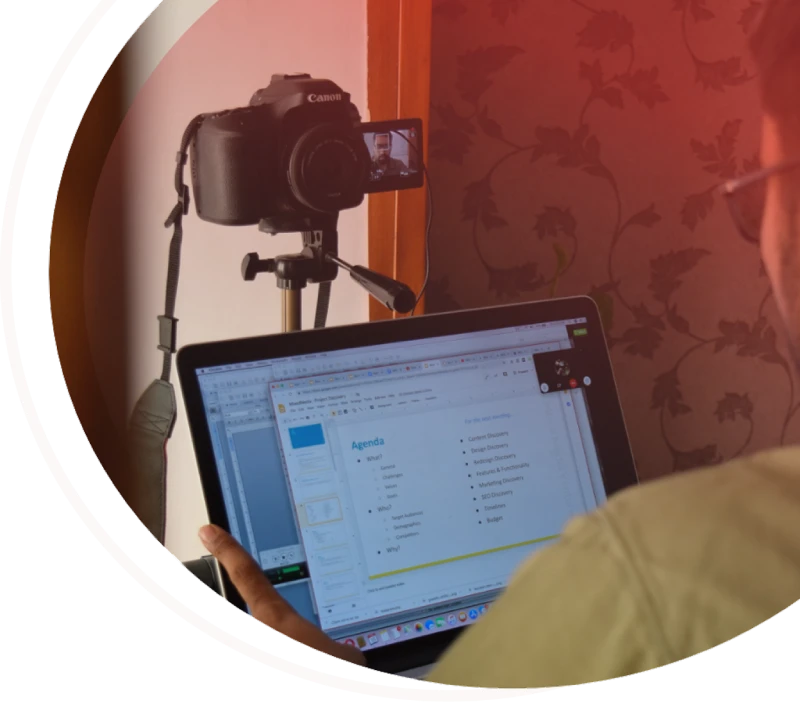
5. Crystal
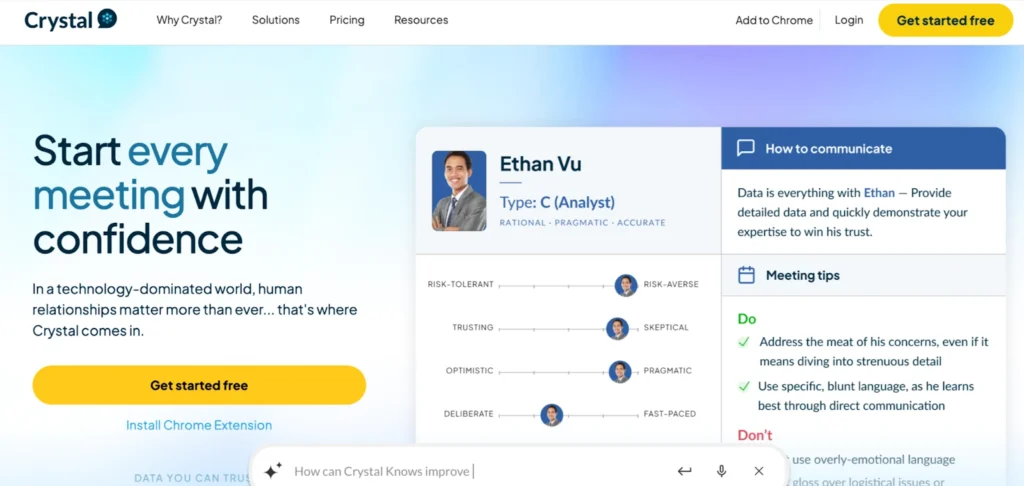
Source: Crystal
Crystal analyses LinkedIn profiles to determine the communication style and preferences of your target audience. This helps you adapt your LinkedIn summary, posts, and outreach messages so they resonate more effectively.
It’s especially useful for sales and marketing teams who want to project the right tone in both their public profile and one-to-one messages, building faster trust with prospects.
Pricing: Free limited insights; Pro starts at $49/month (~£39).
B. Content Management & Scheduling
6. Buffer
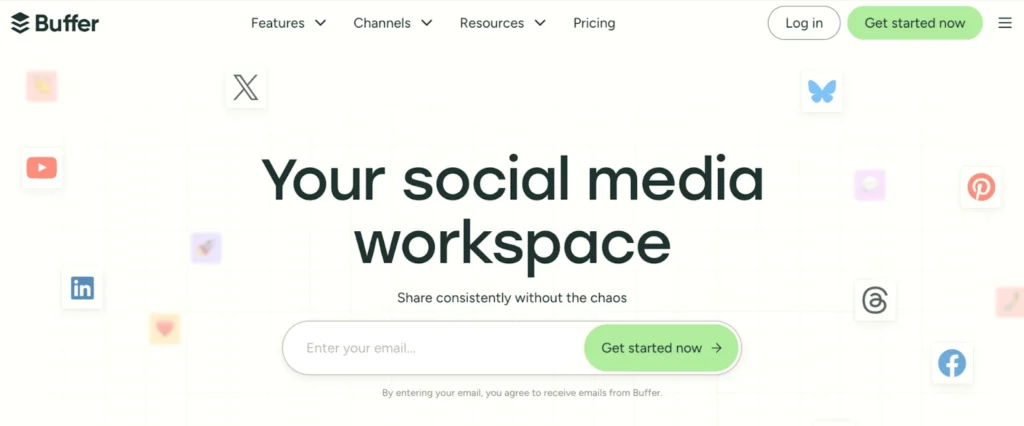
Source: Buffer
Buffer streamlines LinkedIn content planning with features for scheduling, media attachments (images, videos), and performance analytics—all in a neat, intuitive dashboard.
Its AI Assistant helps you optimise post timing and headlines based on past data, making it ideal for small businesses or solo marketers aiming for consistency without the overhead.
Pricing: Free plan allows up to 10 scheduled posts across 3 channels. The Essentials tier is $6/month per channel (billed monthly) or $5/month when billed annually; the Team plan is $12/month per channel, with starts at $120/month for 10 channels for agencies or multiple teams.
7. Hootsuite
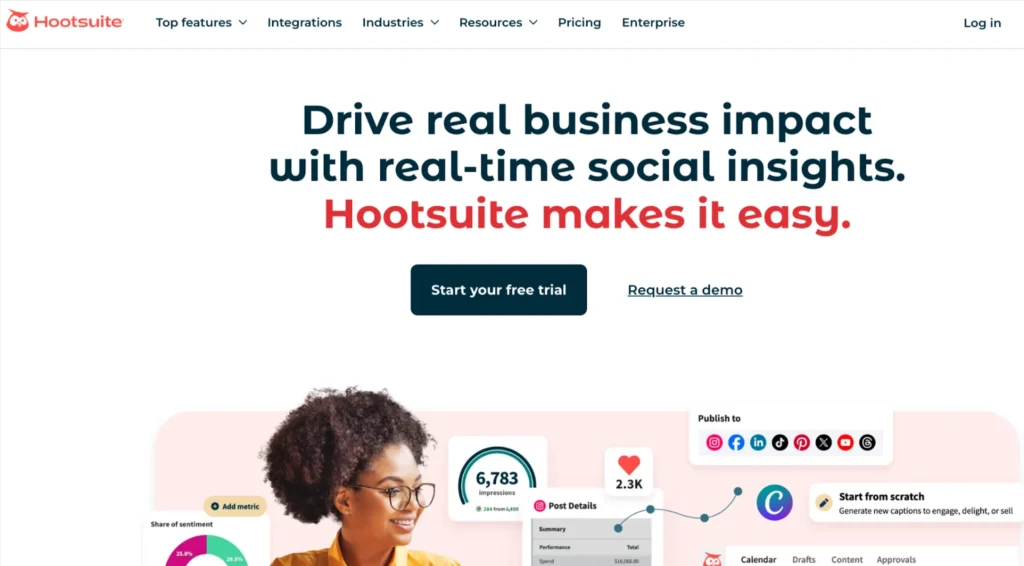
Source: Hootsuite
Hootsuite offers enterprise-ready scheduling, analytics, message inbox, and ad management across platforms, including LinkedIn.
Its professional-level features include AI caption writers, campaign tracking, cross-platform scheduling, and social listening to keep you at the forefront of industry conversations.
Pricing: Monthly billing starts at $149/month for the Professional plan, $399/month for Team (billed annually slightly lower), with Enterprise packages requiring custom pricing—typically from $18,000/year.
8. Sprout Social
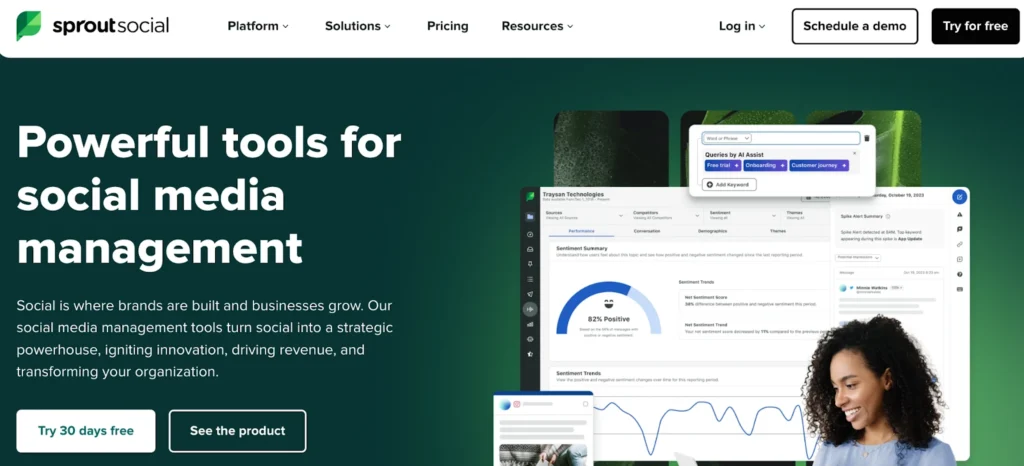
Source: Sprout Social
Sprout Social is a premium social media management platform especially valued by agencies and larger marketing teams.
It delivers powerful LinkedIn capabilities like cross-channel analytics, social listening, detailed sentiment reporting, and collaborative dashboards—making lead generation, audience monitoring, and engagement tracking seamless.
(Pricing is typically over £79 per user per month, depending on feature access.) But they offer a 30-day free trial.
9. SocialPilot
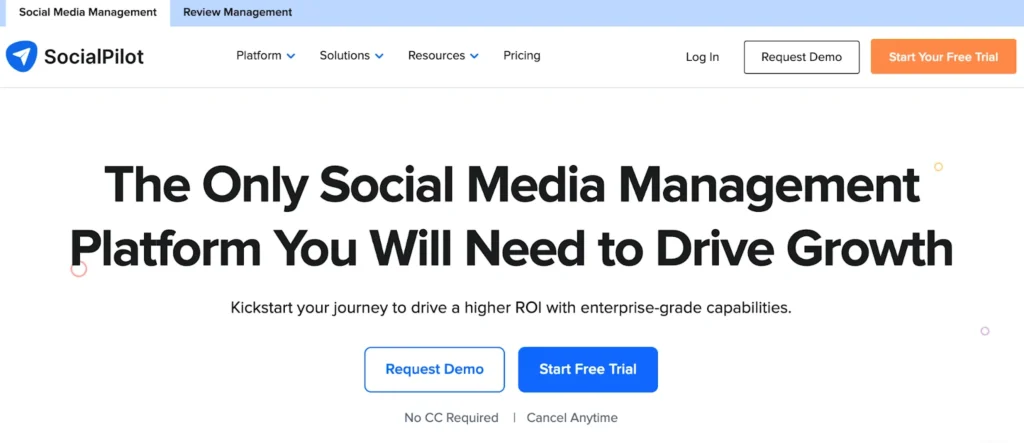
Source: SocialPilot
SocialPilot provides advanced scheduling options—bulk posting (up to 500 entries at once), curated content discovery, and seamless Canva integration.
It supports LinkedIn carousel formats and offers AI-powered content suggestions that are especially useful for small to mid-sized marketing teams operating on tighter budgets.
Pricing: Starts at approximately £21/month, with annual billing optional and agency-level plans offering more features.
C. Analytics & Insights
10. Shield
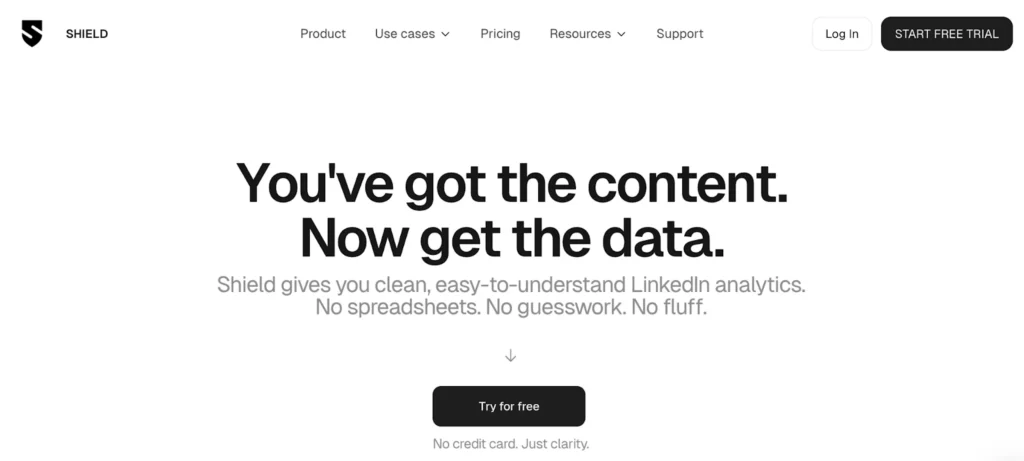
Source: Shieid
Shield offers LinkedIn-specific analytics that go far beyond the platform’s native insights—tracking metrics such as post performance, profile views, follower growth, and audience demographics, all through an intuitive dashboard.
It’s especially useful for businesses and creators seeking clarity and deeper content understanding.
Recently, Shield added competitor benchmarking, enabling you to compare your performance against similar profiles for strategic advantage.
Pricing: Plans start at approximately $8/month for the Starter tier, $16/month for Creator, and $25/month for Influencer level features. Annual billing discounts may apply. scripe.io
11. Brandwatch Suite
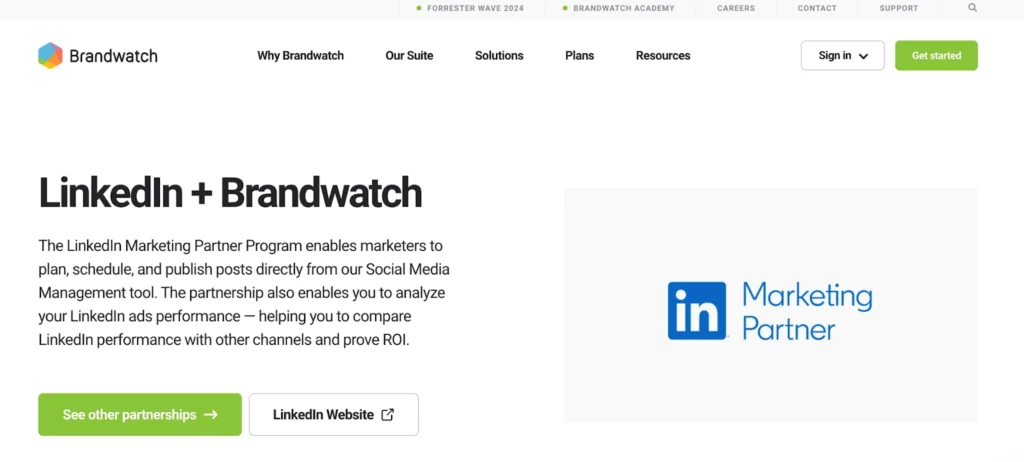
Source: Brandwatch
Brandwatch is a robust enterprise-grade marketing suite that spans content publishing, community engagement, ad analytics, social listening, and deep consumer insight.
Built for campaign managers and brands operating at scale, it now includes AI-powered predictions to forecast content performance before launch.
Pricing: Brandwatch pricing is customised based on organisational needs and scale. Expect enterprise-level investment, often reaching tens of thousands annually, and the best approach is to contact their sales team for a tailored quote.
12. LinkedIn Native Analytics & Campaign Manager
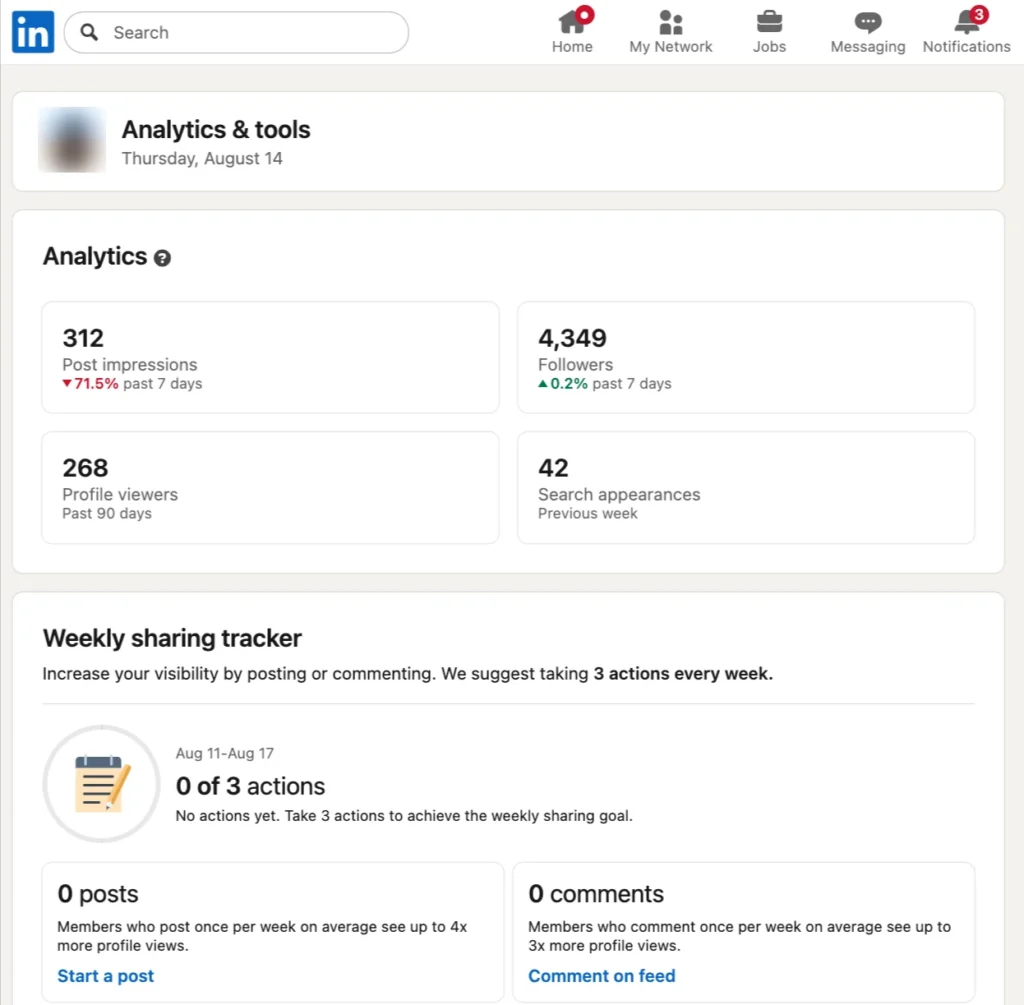
Source: LinkedIn
Still essential for every business, LinkedIn’s built-in analytics and ad tools offer immediate insights into post reach, reaction breakdowns, profile traffic, and paid campaign metrics like conversions and lead collection.
Newer enhancements provide deeper competitor tracking and more precise lead form performance metrics—making it a valuable source for organic and paid performance benchmarking.
D. Outreach & Lead Generation
13. LinkedIn Sales Navigator
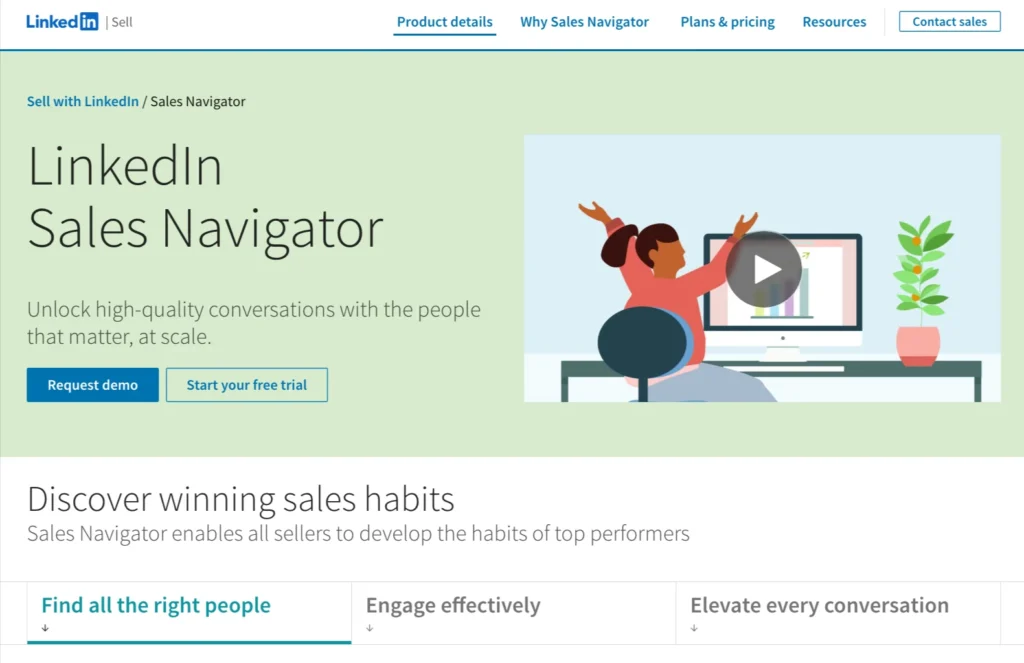
Source: Sales Navigator
Sales Navigator is LinkedIn’s premium platform tailored specifically for sales teams and B2B marketers.
It offers advanced search filters, CRM integrations, InMail credits, and AI-driven lead recommendations. It’s an essential tool for businesses that rely on targeted outreach and relationship building.
Pricing:
- Core (Professional): $99.99/month or around £80/month when billed annually.
- Advanced (Team): $149.99/month or £108/month with annual billing.
- Advanced Plus (Enterprise): Custom pricing starting from around $1,600/year per seat.
14. Expandi
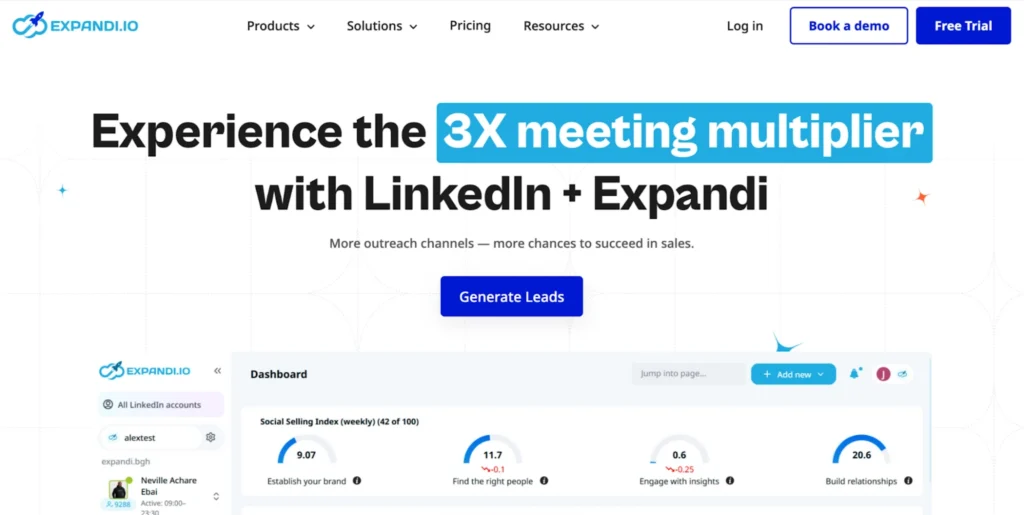
Source: Expandi.io
Expandi automates LinkedIn outreach safely by mimicking human behaviour.
You can create multi-step campaigns, send personalised connection messages, and control daily activity limits to stay compliant. Expandi also offers advanced analytics and its new AI Analyser to optimise message performance.
Pricing:
- Business Plan: $99/month per LinkedIn account, with a 7-day free trial available. Custom pricing is available for agencies or multiple seats.
15. Zapier
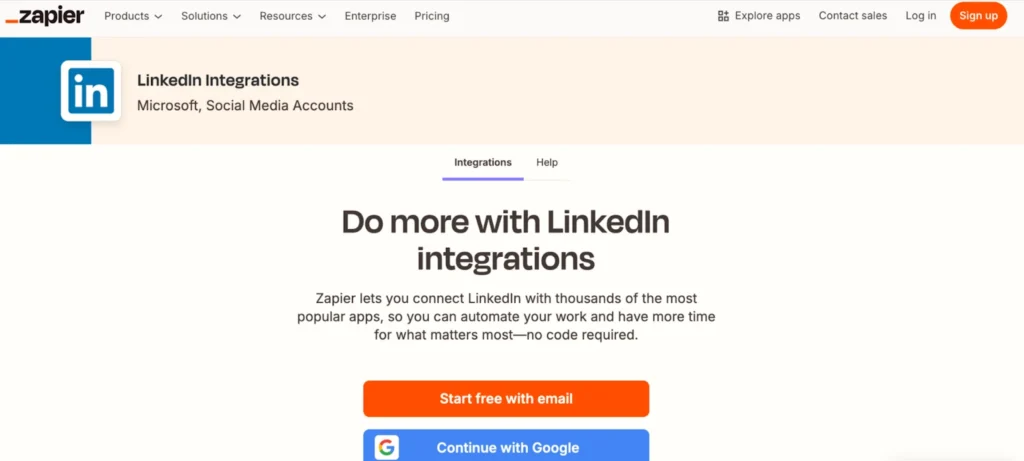
Source: Zapier
Zapier connects LinkedIn with thousands of other apps—automating workflows like syncing LinkedIn leads to CRMs, sending Slack alerts for new connections, or triggering email drip campaigns. Its AI workflow options simplify automation setup and management.
Pricing:
- Free: 100 tasks/month, unlimited simple Zaps.
- Pro: From $15.20 (billed annually) — includes multi-step Zaps and premium app access.
Marketing Research & Strategy
We help you understand your market and build smart strategies to attract more customers and grow faster.
- Detailed research into your competitors, customers, and market
- Custom marketing and growth plans that drive real results
- Clear action steps to increase traffic, leads, and sales

ADWORDS ROI
Cut Ad spend

How to Integrate LinkedIn Tools into Your Workflow
To get the best results from LinkedIn marketing tools, you need a smooth workflow where each tool plays a defined role. Instead of treating them as separate apps, think of them as parts of one integrated system.
A proven workflow for lead generation might start with Resume Worded to refine your profile, making it more appealing to potential clients or partners.
Next, you’d use AnswerThePublic or Writesonic to generate content ideas, ensuring they’re relevant to your niche.
Canva or another design tool can then transform those ideas into engaging visuals, followed by Buffer or Iconosquare for scheduling at optimal times. Finally, you’d track engagement and adjust strategy using Shield or LinkedIn Analytics.
For content planning and repurposing, the process could be:
- 1. Profile polish – Ensure your headline, about section, and visuals reflect your brand.
- 2. Content ideation – Use keyword and topic tools to map out a posting calendar.
- 3. Scheduling – Queue posts across time zones with analytics-backed timing.
- 4. Outreach – Send connection requests or InMails via Sales Navigator or Expandi to engage with the right audience.
- 5. Analytics review – Use dashboards to assess what works and double down on top-performing formats.
By connecting these steps with automation platforms like Zapier, you can reduce manual work, maintain consistency, and respond faster to opportunities.
Top LinkedIn Trends in 2025 Businesses Should Know About
LinkedIn is evolving quickly, and businesses that adapt to its newest trends will see better reach, engagement, and ROI.
1. Pivot to Video and Creator Tools
Video is now central to LinkedIn’s content strategy. In 2025, LinkedIn reports that video content is shared 20× more than other formats, with views up 36% year-over-year.
Creator tools have expanded to include built-in video editing, captions, and performance analytics—making it easier for marketers to publish professional-looking video at scale.
Businesses that adopt a “video-first” mindset will stand out in the feed.
2. Rise of Data-Driven Attribution and Personalised Targeting
LinkedIn’s new LiDDA transformer model enables more accurate tracking of how different touchpoints contribute to conversions. This means marketers can see exactly which posts, ads, or messages lead to business results.
Combined with advanced audience segmentation, you can now personalise outreach and content based on industry, role, or even recent engagement behaviour—boosting relevance and response rates.
3. AI-Driven Notifications and Engagement via Graph Neural Networks
Behind the scenes, LinkedIn is using Graph Neural Networks to predict and prioritise the content and interactions users are most likely to respond to.
This means your content has a higher chance of reaching the right people if it’s relevant, timely, and engaging. For marketers, it’s a push toward posting content that sparks interaction—not just impressions.
Staying ahead of these trends requires more than just posting frequently—it’s about aligning your strategy with how LinkedIn’s algorithms, AI models, and creator tools are shaping the platform’s future.
4. CEOs Using Informal Video for Authentic Brand Presence
More business leaders are embracing unscripted video on LinkedIn to connect genuinely with stakeholders. According to LinkedIn’s own data, there has been a 52% increase in posts shared by chief executives over the past two years.
This trend underscores how much more active CEOs have become on the platform.
Notably, this surge aligns with LinkedIn’s shift toward prioritising video content.
Executives today often embrace unscripted, short-form videos to connect genuinely and transparently with audiences, a format that drives higher engagement and stronger visibility.
5. LinkedIn Strengthening Creator Economy with Original Programming
LinkedIn is doubling down on the creator economy by launching new original video programming through its BrandLink initiative.
Featuring business creators like Steven Bartlett and Rebecca Minkoff, these shows drive high-quality engagement and help creators monetise their content directly on the platform.
This comes at a time when video viewership has grown by 36% year-over-year, and video formats are increasingly outpacing traditional post, Business Insider.
Conclusion
LinkedIn in 2025 isn’t just a networking platform; it’s a dynamic, data-rich marketing hub where the right tools can multiply your reach and results.
With over 1.2 billion members and engagement rates at record highs, the opportunity for B2B growth has never been greater.
The tools we’ve covered, from AI-powered profile optimisers to advanced analytics and automation platforms, are designed to help you save time, scale your efforts, and connect with the right people at the right time.
The most successful marketers on LinkedIn don’t just post—they track, test, and optimise every step of their workflow.
If you haven’t already, choose one new tool from this list to try in the next quarter. Small, consistent upgrades to your LinkedIn strategy can lead to massive gains over time.
And if you’ve already built your own stack, share it with your network—you might inspire someone else’s breakthrough.
Frequently Asked Questions (FAQs)
Is Sales Navigator worth it in 2025?
Yes—especially for B2B marketers, recruiters, and sales teams. The 2025 update adds smarter AI lead recommendations, deeper CRM integrations, and better targeting, making it easier to find and connect with high-value prospects.
How much time can automation tools like Expandi save?
Expandi can save several hours a week by automating outreach sequences, follow-ups, and connection requests. Many users report a 30–50% reduction in manual LinkedIn tasks without sacrificing personalisation.
Should I focus on video content on LinkedIn?
Absolutely. Video posts are shared 20× more than other content formats and views are up 36% year-over-year. With LinkedIn’s built-in creator tools, high-quality videos are easier to produce and distribute than ever.
Which LinkedIn automation tool is best?
For safe outreach automation, Expandi is one of the top choices in 2025. For broader workflow automation, Zapier connects LinkedIn with thousands of apps, letting you automate tasks across your entire marketing stack.
How to use LinkedIn to generate leads?
Optimise your profile, share value-driven content, use advanced search filters (Sales Navigator), and engage consistently with your target audience. Supplement with outreach automation tools for scale.
What are the marketing tools for LinkedIn?
They include profile optimisers, content creation platforms, scheduling tools, analytics dashboards, outreach automation, and workflow integration apps—like those listed in this guide.
What is the 5-3-2 rule on LinkedIn?
Out of every 10 posts: 5 should be curated from others, 3 should be your own insights, and 2 should be personal or humanising content. This keeps your feed balanced and engaging.
How is LinkedIn used for marketing?
Marketers use it for brand awareness, thought leadership, lead generation, recruitment, and event promotion—leveraging both organic posting and paid advertising.
What is the 95-5 rule in LinkedIn?
It’s a marketing principle suggesting that at any given time, only 5% of your potential audience is actively looking to buy, while 95% aren’t ready yet—so brand-building and relationship-nurturing are critical.
Where are the tools on LinkedIn?
Some tools—like LinkedIn Analytics and Campaign Manager—are built into the platform under your profile’s “Analytics” or “Advertise” sections. Others are third-party apps that integrate with LinkedIn via API or safe browser extensions.




